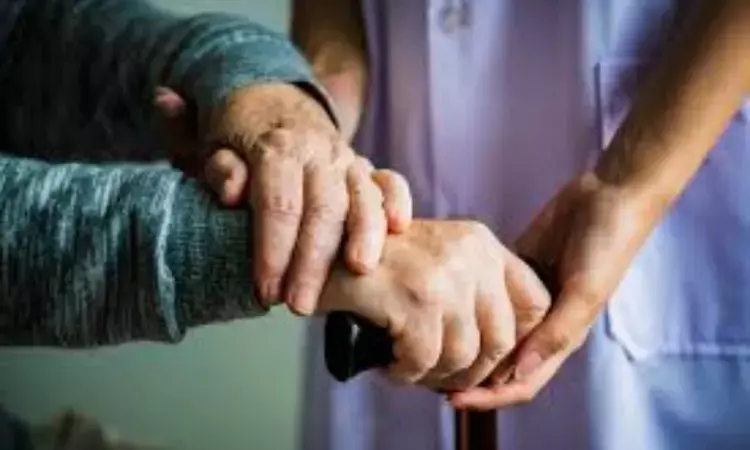- Home
- Medical news & Guidelines
- Anesthesiology
- Cardiology and CTVS
- Critical Care
- Dentistry
- Dermatology
- Diabetes and Endocrinology
- ENT
- Gastroenterology
- Medicine
- Nephrology
- Neurology
- Obstretics-Gynaecology
- Oncology
- Ophthalmology
- Orthopaedics
- Pediatrics-Neonatology
- Psychiatry
- Pulmonology
- Radiology
- Surgery
- Urology
- Laboratory Medicine
- Diet
- Nursing
- Paramedical
- Physiotherapy
- Health news
- Fact Check
- Bone Health Fact Check
- Brain Health Fact Check
- Cancer Related Fact Check
- Child Care Fact Check
- Dental and oral health fact check
- Diabetes and metabolic health fact check
- Diet and Nutrition Fact Check
- Eye and ENT Care Fact Check
- Fitness fact check
- Gut health fact check
- Heart health fact check
- Kidney health fact check
- Medical education fact check
- Men's health fact check
- Respiratory fact check
- Skin and hair care fact check
- Vaccine and Immunization fact check
- Women's health fact check
- AYUSH
- State News
- Andaman and Nicobar Islands
- Andhra Pradesh
- Arunachal Pradesh
- Assam
- Bihar
- Chandigarh
- Chattisgarh
- Dadra and Nagar Haveli
- Daman and Diu
- Delhi
- Goa
- Gujarat
- Haryana
- Himachal Pradesh
- Jammu & Kashmir
- Jharkhand
- Karnataka
- Kerala
- Ladakh
- Lakshadweep
- Madhya Pradesh
- Maharashtra
- Manipur
- Meghalaya
- Mizoram
- Nagaland
- Odisha
- Puducherry
- Punjab
- Rajasthan
- Sikkim
- Tamil Nadu
- Telangana
- Tripura
- Uttar Pradesh
- Uttrakhand
- West Bengal
- Medical Education
- Industry
Increased prevalence of osteosarcopenia observed among hip fracture patients, suggests research

A new study published in the Journal of Orthopaedic Surgery and Research showed that more than 80% of patients with hip fractures had osteosarcopenia, 83.6% had sarcopenia, and 97.95% had osteopenia/osteoporosis.
As the world's population ages, hip fractures are expected to affect 6.3 million people globally by 2050. It is well known that hip fractures require prompt surgery. The primary goal is early mobilization and recovery in order to lower mortality and avoid potentially deadly medical consequences. In addition to the substantial risk of pain and impairment for those who survive, the global death rate is around 10% at one month and 36% at one year. Yet, hip fractures cause 4.5 million disabilities annually and rank in the top 10 worldwide, despite intensive intervention and rehabilitation.
Sarcopenia is characterized by a decrease in the size and quantity of muscle fibers, which may be brought on by changes in the central and peripheral neurological systems, hormones, immunological factors, and lifestyle choices. A rising geriatric monster, osteosarcopenia increases the risk of falls, fractures, disability, and death. Determining the frequency and risk factors of osteosarcopenia in individuals with hip fractures was the aim of this cross-sectional investigation.
A dual energy x-ray absorptiometry (DXA) scan was performed on each patient to diagnose osteopenia and osteoporosis. The patients were given a 5-time chair stand test, a bioimpedance analysis (BIA) measurement, and a handgrip strength test to evaluate sarcopenia. When sarcopenia and osteopenia/osteoporosis coexist, it's called osteosarcopenia. Using logistic regression, risk variables for osteosarcopenia were examined.
A total of 342 individuals with hip fractures (n = 342) were enlisted. Nearly, 286 individuals with hip fractures (83.6%) had sarcopenia. Osteopenia/osteoporosis was seen in 335 hip fracture patients (97.95%). Also, 281 individuals (82.2%) with hip fractures had osteosarcopenia.
Regardless of age or gender, individuals with a body mass index (BMI) < 23 kg/m2 had a 4.33-fold increased risk of developing osteosarcopenia. And, regardless of age or BMI group, the risk of osteosarcopenia was 3.24 times higher in men.
Overall, osteosarcopenia was shown to be extremely common in hip fracture patients, particularly in male patients, and related risk and protective variables were also discovered. Given the possible clinical ramifications, this study advise that routine sarcopenia evaluation be included in Fracture Liaison Services in addition to bone mineral density examination.
Source:
Wong, R. M. Y., Wong, P. Y., Chau, W. W., Liu, C., Zhang, N., & Cheung, W. H. (2025). Very high prevalence of osteosarcopenia in hip fracture patients: risk and protective factors. Journal of Orthopaedic Surgery and Research, 20(1), 423. https://doi.org/10.1186/s13018-025-05828-7
Neuroscience Masters graduate
Jacinthlyn Sylvia, a Neuroscience Master's graduate from Chennai has worked extensively in deciphering the neurobiology of cognition and motor control in aging. She also has spread-out exposure to Neurosurgery from her Bachelor’s. She is currently involved in active Neuro-Oncology research. She is an upcoming neuroscientist with a fiery passion for writing. Her news cover at Medical Dialogues feature recent discoveries and updates from the healthcare and biomedical research fields. She can be reached at editorial@medicaldialogues.in
Dr Kamal Kant Kohli-MBBS, DTCD- a chest specialist with more than 30 years of practice and a flair for writing clinical articles, Dr Kamal Kant Kohli joined Medical Dialogues as a Chief Editor of Medical News. Besides writing articles, as an editor, he proofreads and verifies all the medical content published on Medical Dialogues including those coming from journals, studies,medical conferences,guidelines etc. Email: drkohli@medicaldialogues.in. Contact no. 011-43720751


